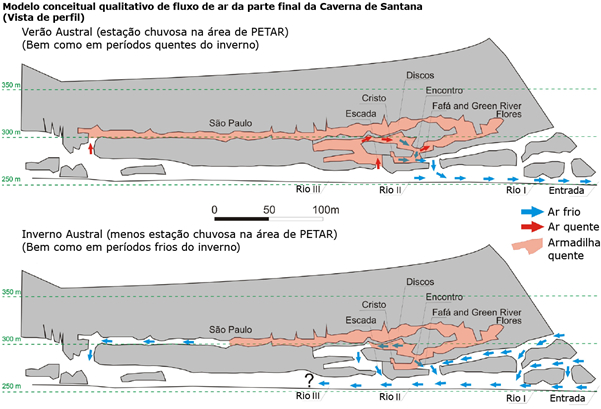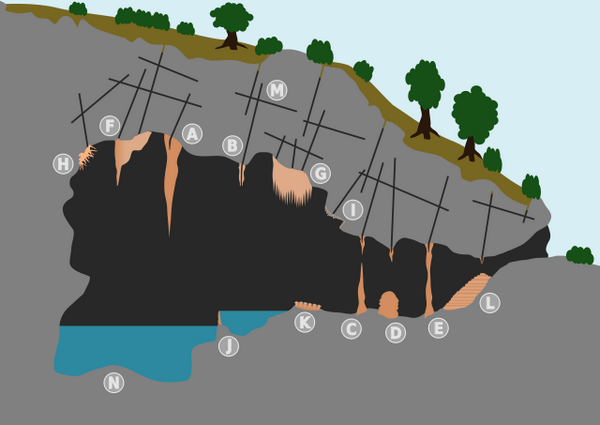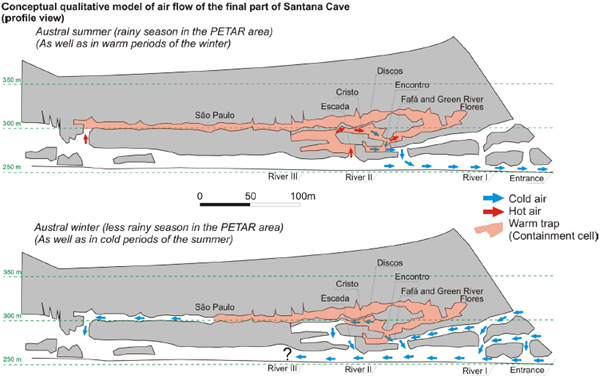|
A Caverna de Santana está localizada dentro de uma área natural protegida (PETAR - Parque Estadual de Turismo do Alto Ribeira) que é conhecida por muitas cavernas e área de Mata Atlântica. A caverna, que se desenvolveu em rochas carbonáticas neoproterozóicas do Grupo Açungui, apresenta 8.373 m de passagens e galerias conhecidas, das quais apenas 480m são utilizadas para turismo devido a restrições ambientais.
A caverna está localizada na bacia hidrográfica da Ribeira, que é caracterizada por um clima úmido que é influenciado por massas de ar tropicais e polares. A atmosfera na área que circunda a caverna é influenciada pela presença de depressões íngremes no fundo do vale (karst do cockpit) ea vegetação espessa da floresta tropical atlântica.
A umidade relativa é aproximadamente 100% durante todo o ano, mas flutuações diárias podem ocorrer devido à incidência local da luz solar; A umidade relativa pode cair para 60% e depois retornar à saturação total à noite. A precipitação média anual é de cerca de 1.500 mm. A distribuição da chuva não é homogênea; Aproximadamente 33% da chuva anual ocorre no verão austral (dezembro a fevereiro), enquanto 18% da chuva anual ocorre durante o inverno austral (junho a agosto). A temperatura média regional a longo prazo é de 19 ° C a 21 ° C e os estudos na caverna de Santana mediram uma média de 18,6 ° C fora da caverna.
A estrutura física da caverna, que inclui uma extensa rede de galerias acima do nível de base, força as massas de ar mais frias encontradas no interior da caverna a fluir para o exterior durante os períodos mais quentes. O fluxo inverte quando o ar exterior é mais frio do que o ar dentro da caverna, por exemplo, no inverno Austral. (Ver figura abaixo)

Mais informações sobre scholarcommons.usf.edu/ijs: "Speleoclimate dynamics in Santana Cave (PETAR, São Paulo State, Brazil): general characterization and implications for tourist management" by Heros A. S. Lobo, Paulo C. Boggiani, José A. J. Perinotto, International Journal of Speleology, 44 (1), 61-73. Tampa, FL (USA) January 2015
Caverna de Santana é uma caverna solúvel. Gaseificadas, fluindo e, em particular, pingando água com fluxo de água muito baixo é a causa da deposição lenta de calcita. O gás de dióxido de carbono escapa e assim precipita o carbonato de cálcio. Ao longo de milhares de anos (crescimento médio de cerca de 1 mm por década na caverna de Santana) este processo pode resultar em formações populares dripstone como estalactites, estalagmites, helictites, palhetas de soda, cortinas ou pilares. Nos últimos tempos, o termo "espeleotemas" tem sido cada vez mais usado, mas basicamente este termo refere-se a todos os tipos de depósitos secundários em cavernas e não apenas a formações de dripstone (veja a figura 2 a seguir para exemplos).

A - Estalactite, B - Makkaroni / Palha de soda, C - Stalagmite (Vela), D - Estalagmite em forma de cone, E - Pilar, F - Xaile / Crosta de bacon, G - Cortina, H - Helictites, I - Leite da lua, J - Piscinas da pedrinha, K - Cristais da calcita, L - Terraços da pedrinha, M - Lacuna de cársico, N - Rios e Lagos
A origem: By chris 論 (Own work) [GFDL or CC BY 3.0], via Wikimedia Commons
QUESTÕES:
- No dia da sua visita: É mais frio dentro ou fora da caverna?
- Tomando a sua resposta para a primeira questão em conta: Você acha que o ar flui para dentro da caverna ou do interior da caverna para o exterior?
- Que tipos de espeleotemas você viu durante sua visita à caverna? Consulte a figura 2.
- As cores principais que você vê são branco (calcite) e azul / cinza (rocha circunvizinha). Mas, ocasionalmente, você também vê uma cor acastanhada dentro das rochas. O que você acha que é isso?
- (Bônus, voluntário) Eu ficaria muito feliz, se você postar fotos de si mesmo ou seu GPS na caverna e, claro, também caiu para postar fotos dos espeleotemas na caverna que você mais gosta.
==> Envie as respostas para as perguntas por e-mail ou pelo centro de mensagens (preferido). Você pode registrar o geocache diretamente após sua visita. Eu entrarei em contato com você, se algo está errado.
(Graças a Creusa Dias da Agência Cave Atlântica temos o controle da tradução para o Português!)
***************************************************************************
Santana Cave is located within a natural protected area (PETAR – State Tourist Park of Alto Ribeira) that is known for many caves and area of Atlantic rainforest. The cave, which developed in Neoproterozoic carbonaceous rocks of the Açungui Group, presents 8,373 m of known passages and galleries of which only approximately 480 m are used for tourism due to environmental restrictions.
The cave is located in the Ribeira hydrographic basin, which is characterized by a humid climate that is influenced by tropical and polar air masses. The atmosphere in the area surrounding the cave is influenced by the presence of steep hollows in the bottom of the valley (cockpit karst) and the thick vegetation of the Atlantic rainforest.
The relative humidity is approximately 100% throughout the year, but daily fluctuations may occur due to the local incidence of sunlight; the relative humidity can drop to 60% and then return to total saturation in the evening. The annual average rainfall is close to 1,500 mm. The distribution of the rain is not homogeneous; approximately 33% of the annual rain occurs in the austral summer (December to February), whereas 18% of the annual rain occurs during the austral winter (June to August). The long-term regional average temperature is 19°C to 21°C and studies in Santana cave measured an average of 18.6°C outside the cave.
The physical structure of the cave, which includes an extensive network of galleries above the base level, forces the coldest air masses found in the interior of the cave to flow toward the outside during the warmest periods. The flow reverses when the air outside is colder than the air inside the cave, e.g. in Austral winter. (see fig. 1 below)

More information on scholarcommons.usf.edu/ijs: “Speleoclimate dynamics in Santana Cave (PETAR, São Paulo State, Brazil): general characterization and implications for tourist management” by Heros A. S. Lobo, Paulo C. Boggiani, José A. J. Perinotto, International Journal of Speleology, 44 (1), 61-73. Tampa, FL (USA) January 2015
Santana Cave is a solutional cave. Carbonated, flowing and, in particular, dripping water with very low water flow is the cause of the slow deposition of calcite. Carbon dioxide gas escapes and thereby calcium carbonate precipitates. Over thousands of years (average growing of about 1 mm per decade in Santana Cave) this process may result in popular dripstone formations like stalactites, stalagmites, helictites, soda straws, curtains or pillars. In recent times, the term "speleothem" has been increasingly used, but basically this term refers to all types of secondary deposits in caves and not only to dripstone formations (see fig. 2 below for examples).

A - Stalactite, B - Makkaroni/Soda Straw, C - (Candle-)Stalagmite, D - Cone-shaped Stalagmite, E - Pillar, F - Shawl/Bacon Rind, G - Curtain, H - Helictites, I - Moonmilk, J - Rimstone Pools, K - Calcyte Crystals, L - Rimstone Terraces, M - Karst Gap, N - Rivers and Lakes
Source: By chris 論 (Own work) [GFDL or CC BY 3.0], via Wikimedia Commons
QUESTIONS:
- On the day of your visit: Is it colder inside or outside the cave?
- Taking your answer for the first question into account: Do you think the air flows into the cave or from the interior of the cave toward the outside?
- Which kinds of speleothems did you see during your visit of the cave? Refer to picture 2.
- The main colours you see are white (calcite) and blue/gray (surrounding rock). But occasionally you also see a brownish colour within the rocks. What do you think is this?
- (Bonus, voluntary) I would be very happy, if you post pictures of yourself or your GPS in the cave and of course, fell also free to post pictures of the speleothems in the cave which you like the most.
==> Send the answers to the questions via e-mail or through the message center (preferred). You can log the geocache directly after your visit. I will contact you, if something is wrong.
(Thank you to Creusa Dias of Agência Cave Atlântica for checking the Portuguese translation!)
|